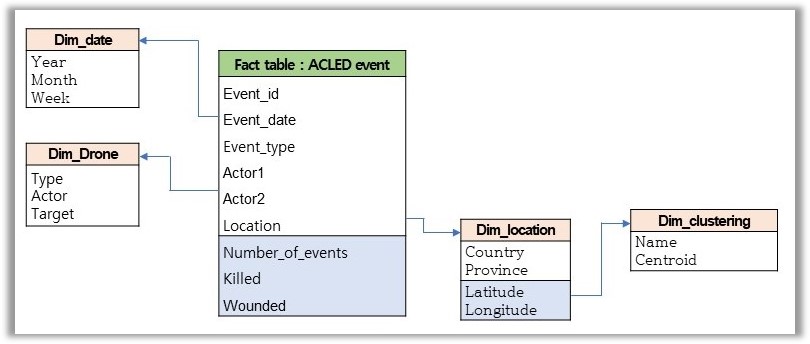Spatiotemporal analysis of drone operations using armed conflict location and event data (ACLED): Focusing on the Russia-Ukraine war
DOI:
https://doi.org/10.37944/jams.v6i3.230Keywords:
drone-based battles, Russia-Ukrainian war, hotspot, multidimensional analysis, spatiotemporal analysisAbstract
This study was designed to determine the characteristics and tendencies of drones, which have emerged as a key weapon system in the Russian-Ukrainian War since 2022, and their use in modern warfare. A spatiotemporal analysis was conducted on 5,491 coordinates of drone-based battles within the city with a multidimensional model. The analysis revealed extensive drone operations by both Russia and Ukraine, with Ukraine shifting to offensive actions in 2023, and distinct temporal patterns by day of the week at battle sites, as indicated by the frequency of drone-based battles. Moreover, Russia maintained the momentum of offensive drone operations, intercepting 85.1% of Ukrainian drones and achieving a 54.0% success rate in drone-based attacks, whereas Ukraine intercepted 43.3% of Russian drones, with a success rate of only 14.3%. Based on this study, the spatiotemporal analysis of drone-based combat across Ukraine enabled an examination of the operating areas, roles, and efficiency of this weapon system as well as an understanding of the impact and multifaceted characteristics associated with its deployment on the battlefield.
Metrics
References
Baik, E. Y., & Cho, J. H. (2013). Analysis of Airline Network using Incheon and Narita Passenger Flight Origin-Destination Data. Journal of Information Technology Applications & Management, 20(1), 87-106. UCI : G704-000870.2013.20.1.007
Chae, H., Lee, K. S., & Eom, J. H. (2023). The Development of Artificial Intelligence-Enabled Combat Swarm Drones in the Future Intelligent Battlefield. Journal of Convergence Security, 23(3), 65-71. https://doi.org/10.33778/kcsa.2023.23.3.065
Chang, S., Pierson, E., Koh, P. W., Gerardin, J., Redbird, B., Grusky, D., & Leskovec, J. (2021). Mobility network models of COVID-19 explain inequities and inform reopening. Nature, 589(7840), 82-87. https://doi.org/10.1038/s41586-020-2923-3
Cho, J. H., & Seo, I. J. (2006). Multidimensional Model for Spatiotemporal Data Analysis and Its Visual Representation. Journal of Information Technology Applications & Management, 13(1), 137-147. UCI : G704-000870.2006.13.1.001
Choi, M. W., Moon, H. S., Han, S. W., & Cho, N. S. (2021). An ABM Simulation Study on Operational Effectiveness and Mission Organization for Swarm Drones. Journal of the Military Operations Research Society of Korea, 47(2), 75-90. https://www.dbpia.co.kr/pdf/pdfView.do?nodeId=NODE11062017
Enders, E., & Sandler, T. (2000). Is transnational terrorism becoming more threatening? A time-series investigation. Journal of Conflict Resolution, 44(3), 307-332. https://doi.org/10.1177/0022002700044003002
Esenbuğa, Ö. G., Akoğuz, A., Çolak, E., Varol, B., & Erol, B. (2016). Comparison of principal geodetic distance calculation methods for automated province assignment in Turkey. International Multidisciplinary Scientific GeoConference: SGEM, 2, 141-148. https://doi.org/10.1109/INNOCIT.2017.8319153
Hägerstrand, T. (1970). What about people in regional science. regional science association, 24. https://courses.washington.edu/cee500/What%20about%20people%20in%20regional%20science.pdf
Halem, H. (2023). Ukraine’s Lessons for Future Combat: Unmanned Aerial Systems and Deep Strike, The US Army War College Quarterly Parameters, 53(4). https://doi.org/10.55540/0031-1723.3252
Kim, E. Y. (2010). Spatial Analysis of Terrorism Incidences in the United Kingdom. Korean terrorism studies Review, 3(2), 71-96. UCI : G704-SER000003128.2010.3.2.001
Kim, T. W. (2022). A Study on the Tourism Popularity Analysis Methodology Using T-map Search Sites and Sometrend Data: Focused on Four Cities in Gangwon-do. [Ph.D. dissertation, Kwangwoon University]
Kim, T. Y., Choi, C. K., & Lee, J. W. (2021). A quantitative study on patterns of Drone terrorism. Journal of Korean Public Police and Security Studies, 18(4), 55-79. https://doi.org/10.25023/kapsa.18.4.202111.55
Kunertova, D. (2023). The war in Ukraine shows the game-changing effect of drones depends on the game. Bulletin of the Atomic Scientists, 79(2), 95-102. https://doi.org/10.1080/00963402.2023.2178180
LaFree, G., & Dugan, L. (2009). Research on Terrorism and Countering Terrorism. Crime and Justice, 38(1), 413-477. https://doi.org/10.1086/599201
Lee, B. S., & Lee, S. W. (2023). A study on the status and types of Military Targets terrorism using the Global Terrorism Database. Korean Journal of Public Safety and Criminal Justice, 32(3), 255-282. https://doi.org/10.21181/KJPC.2023.32.3.255
Lee, S. R., & Lee, B. S. (2023). A Study on the Status and Characteristic of Drone Terror. The Journal of Social Convergence Studies, 7(4), 13-25, https://doi.org/10.37181/JSCS.2023.7.4.013
Park, J. S., & Yi, G. Y. (2023). A Study on Operational Patterns for Drone Reconnaissance and Attack Missions. Journal of the Korean Institute of Defense Technology, 5(3), 18-28. https://doi.org/10.52682/jkidt.2023.5.3.18
Park, S. H., Kim, S. K., & Namkung, S. P. (2023). A Study on Overseas Battle Cases Using Combat Drone. The journal of Convergence on Culture Technology, 9(5), 403-407. https://doi.org/10.17703/JCCT.2023.9.5.403
Seo, K. I., Cho, S. K., Kim, J. H., Kim, K. W., & Park, S. H. (2023). 21Century of Combat Aspects of North Korean Attack Drones Through the War of the Century. The journal of Convergence on Culture Technology, 9(3), 299-304. https://doi.org/10.17703/JCCT.2023.9.3.299
Seo, K. I., Kim, K. K., Kim, J. H., Cho, S. K., & Park, S. H. (2023). A Case Study on the Threat of Small Drone and the Development of Counter-Drone System. The journal of Convergence on Culture Technology, 9(2), 327-332. https://doi.org/10.17703/JCCT.2023.9.2.327
Yoon, M. W. (2013). A quantitative study on patterns of terrorist bombing incidents. Korean Security Journal, 36, 317-347. UCI : G704-001904.2013..36.002

Downloads
Published
How to Cite
Issue
Section
License
Copyright (c) 2023 Journal of Advances in Military Studies

This work is licensed under a Creative Commons Attribution 4.0 International License.

This work is licensed under a Creative Commons Attribution 4.0 International License.

이 저작물은 크리에이티브 커먼즈 저작자표시 4.0 국제 라이선스에 따라 이용할 수 있습니다.






